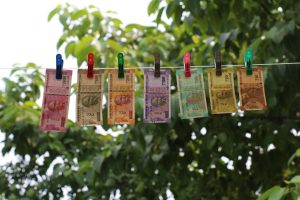Leaving a currency’s value to change based on international forces was always a point of contention throughout the MENA region. On one hand, allowing central banks to manipulate a currency’s foreign exchange rate could be a buffer in the face of domestic and foreign economic crises. However, investors would have to deal with currency exchange risks and sometimes unfriendly monetary decisions.
MENA countries long chose to peg their currencies to the dollar or a basket of currencie s comprising the greenback and euro. By 2016, Egypt, which had a “managed float,” announced it would no longer prop up its currency. The free float had some severe repercussions. The exchange rate more than doubled to EGP 18.7 between October 3, 2016, and January 2, 2017. Inflation more than tripled to 32.5 percent in 2017, sending consumer prices soaring in a matter of a few months.

By 2020, the Central Bank of Egypt (CBE) had increased its foreign currency reserves from $16 billion to $39 billion at press time. The float also helped GDP growth jump from just above 4 percent to 5.6 percent by the end of 2019.
Today, the country is in a good spot as its economy grew in 2020, unlike the rest of the MENA region, according to World Bank forecasts. Egypt’s “financial position was manageable at the outset of the crisis,” noted a June report by The Economist Intelligence Unit (EIU). “These efforts kept the Egyptian pound relatively stable, given the extent of the market strains.”
However, Morocco, Jordan and the GCC continue to peg their currencies to the dollar. In 2021, with new economic lockdowns possible to curb the second wave of COVID-19 and a new strain of the virus, their strategy of fixed foreign exchange rates hangs in the balance.
Limited resources
The EIU’s June report said emerging economies are “under pressure this year.” That is because of concerns about the region’s “vulnerabilities, its weak economic outlook, and the political and financial capacity of certain governments to manage the crisis.”
Foreign currency pressures in emerging markets stem from fewer exports to the West, lower oil prices, declining tourism revenue and remittances dropping due to struggling overseas firms. In 2021, those factors may affect monetary and government policies and strategies noted the EIU report.
Those pressures already have hurt MENA’s 2020 forecasts. The aggregate current account went from a surplus of $78.2 billion (2.1 percent of regional GDP) in 2019 to a forecasted deficit of $190 billion (5.7 percent of GDP) by the end of 2020. “It will remain in deficit until 2022,” noted the EIU report. “Goods export earnings in the region will not return to 2019 levels until 2024.”

In freefall
Not all MENA currencies will suffer to the same extent. The EIU cites Algeria, Lebanon, Yemen, Libya and Syria as countries whose currencies have collapsed, with no option but to accept international assistance.
Lebanon was in the spotlight during 2020 with ongoing protests against economic and COVID-19 policies, and the massive Beirut Port explosion in August. “The currency is in free fall as the country was already crippled by an extended political and financial crisis that had seen the sovereign default in March,” noted the EIU report.
Algeria is not faring any better. “Poor economic management and failure to reform meant the country’s strategic fiscal reserves were depleted in the previous oil price crash [from 2014 to 2016],” said the EIU report. As a result, its reserves dropped from $195 billion in January 2014 to $55 billion in January 2020, according to Algeria’s central bank. Throughout 2020, oil prices dropped by a third compared to the end of 2019, putting more stress on the currency. Oil accounts for 20 percent of the country’s GDP and 85 percent of total exports, according to OPEC.
Meanwhile, ongoing civil wars and conflicts in Yemen, Syria and Libya, coupled with the COVID-19 pandemic, have invariably caused those nations’ currencies to collapse, said the EIU report.

Tiptoeing around the peg
As one of the region’s most diverse economies, Morocco attracted foreign and domestic direct investments while pegging its currency to a combination of the euro (60 percent) and dollar (40 percent), with flexibility to fluctuate by 0.3 percent.
As a result, the country’s largest exports in 2019 were electrical machinery and equipment (18.1 percent), automobiles (13 percent), produce and semi-finished goods (16.7 percent), fertilizer (9.9 percent), clothing (8.3 percent), and high-tech aircraft and spacecraft exports (2.9 percent).
Those exports experienced a temporary setback in 2020, dropping from 25 billion Moroccan dinars (MAD) in February to 14.8 billion in April. By October, however, they had rebounded to MAD 26 billion.
Still, the government relaxed the peg to make exports more competitive and create economic buffers. Since November 2019, Moroccan central bank Governor Abdel Latif Jouahri has been working to “expand dirham circulation by adopting a more flexible exchange rate.”
As a result, the Moroccan dirham appreciated from 10.3 to the dollar to 8.88 in 2020, the strongest exchange rate since 2014. Meanwhile, reserves increased from MAD 250 billion in January 2020 to MAD 292.6 billion by October, while debt-to-GDP was stable at 66.1 percent since 2019.
In 2021, however, the westernmost MENA country may face unprecedented currency pressures due to a second wave of COVID-19.
Untouched by COVID-19?
Jordan’s dinar peg is unyielding, remaining at JOD 0.71 to the dollar since December 2007. That has helped inflation drop from 2.1 percent in March to 0.1 percent in November after going into negative territory from May to August.
Global lockdowns resulted in a slight drop in Jordan’s exports, which went from JOD 570 million during the last quarter of 2019 to just over JOD 250 million by April, before recovering to JOD 523 million by November. Meanwhile, foreign currency reserves jumped from JOD 12.13 billion to JOD 14 billion between July and September, only to drop to JOD 13 in November.
That comes at the expense of taking on more sovereign debt as debt-to-GDP reached 88.38 percent by November versus 78 percent a year earlier.
So far, the peg has protected Jordan’s economy and government finances. “The dinar is very strong, not due to a strong national economy or large scale of exports, but because it has been pegged to the American dollar for the last 20 years,” said economist and columnist Fahed Fanek to the Jordan Times in 2015. Accordingly, Jordan sought no support from the IMF in 2020.
Free trade agreements are one reason why Jordan operated comfortably with its iron-clad peg. The country’s main overall exports are knitted and crocheted items (26.5 percent of exports), followed by inorganic chemicals (14.2 percent), fertilizers (11 percent) and clothing accessories (8.8 percent).
Jordan has a free trade agreement with the United States, which accounts for a quarter of the country’s exports. It is also part of the Greater Arab Free Trade Agreement (GAFTA) countries account for 31 percent of Jordan’s exports.
As it stands, the country is unlikely to consider adjusting the peg to the dollar this year. “Economic decisions are like strong medicines: They are meant to deal with certain problems, but cannot avoid undesirable side effects,” wrote Fanek. “The dinar fixed in dollars served the Jordanian economy well. It achieved monetary stability, reinforced public confidence, attracted Arab and foreign investments, and has been a successful policy by any measure.”

Saving their peg
The six GCC nations, which rely heavily on oil exports, also have long pegged their local currencies to the dollar. “With the dollar-based nature of their economies, the pegs have provided a nominal anchor for inflation, supporting monetary policy credibility by outsourcing it to the U.S. Federal Reserve,” noted S&P Global in June.
However, the rise of shale gas in 2013 in the United States was a problem for GCC countries that no longer could raise oil prices when they needed more revenue. The massive drop in demand in 2020 showed how low oil prices could go. Lastly, the advent of clean energy means global demand likely will not grow as fast as it once did.
“When oil prices fall sharply, investors often question the sustainability of exchange rate arrangements in Gulf Cooperation Council (GCC) countries,” said the S&P Global report in June. The rating agency views all GCC countries as a bloc with the same currency policies. It is a “key assumption that continues to underpin our ratings on GCC sovereigns,” noted the report.
That bloc has two distinct groups measured by “reserves adequacy.” High-ranked countries are Saudi Arabia, the U.A.E., Qatar and Kuwait, with Oman and Bahrain in the second group.
T he top group supports the weaker nations when oil prices crash to maintain the currency peg. In October 2018, Kuwait, the U.A.E. and Saudi Arabia pledged a $10 billion “annual support package,” for Bahrain through 2022.
However, 2021 could be the year when GCC members reconsider the peg as they expedite economic diversification plans. “GCC States have stressed their commitment to supporting strategies and plans aimed at diversifying their sources of national income,” said Thani Al Zeyoudi, U.A.E. minister of state for foreign trade, in December. That would happen “by increasing their non-oil exports,” he explained. Accordingly, adjusting the local currencies to the dollar may become necessary to compete in non-oil sectors.
Additionally, the COVID-19 pandemic has made GCC countries more wary. “Cooperation between GCC states in protecting their exports to foreign markets has become increasingly important,” said Al Zeydouni. That includes “protecting national products by exploring new trade destinations and improving competitiveness,” he noted.
Accordingly, GCC nations are looking to “sign more free trade agreements with countries and economic blocs of strategic importance,” he said. T he aim is to ensure exports are competitive without manipulating the peg.
Saudi Arabia, the U.A.E. and Kuwait have a Trade and Investment Framework Agreement (TIFA) with the United States. “A TIFA is typically an umbrella agreement for ongoing structured dialogue between the United States and foreign governments on economic reform and trade liberalization,” according to a export.gov, a U.S. Commerce Department website.
The U .A.E. has the most FTAs by far, including deals with Singapore and New Zealand. As of August 2019, export.gov reported on talks between the U.A.E. and several South American countries, the EU, central Asian countries and Turkey. The Arab nation, along with 82 other countries, also is part of the Information Technology Agreement “to eliminate tariffs on IT products.” Such agreements mainly benefit free-zone manufacturing complexes, such as the one in Jebel Ali.
Oman and Bahrain are making do with free trade agreements with the United States, which go beyond trade to support the countries’ economic and political reforms. Qatar and Saudi Arabia have no trade deals outside the GCC and GAFTA.
In 2021, pressures may mount on GCC countries to consider adjusting their peg. S&P Global expects oil prices to reach $50 a barrel. According to Oil Price, a specialized portal, in September, oil’s break-even prices for five of the six GCC countries is more than $60 a barrel. Qatar can break even at $40 a barrel. “The view is that sustained pressure on an exchange rate peg and ensuing loss of reserves make existing FX arrangements untenable,” noted a paper by ING Think, a global research firm.
On the other hand, GCC countries in 2021 could face new problems if they consider adjusting their currency pegs. “The loss of the credible anchor would be costly,” said S&P Global. “What kind of devaluation is sufficient, who decides policy and what are their motives?”
COVID factor
As with all countries assessing and planning their economic recoveries in 2021, how they and their trading partners deal with COVID-19 and vaccinations is the starting point. “Across MENA, economic risks will remain fairly high,” said the EIU in its June analysis.
New lockdowns would continue to curb demand for goods and services, including oil. Eventually, that would impact MENA governments’ currency decisions and policies. “These challenges, coupled with persistently weak business and consumer confidence, will weigh on the regional currency outlook,” stressed the EIU report.







